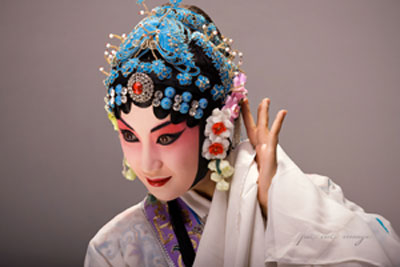

中国戏曲历史悠久,剧种种类繁多,据不完全统计,我国各民族地区的戏曲剧种约有三百六十多种.今天选取其中几种简单介绍.
Traditional Chinese opera is a comprehensive performing art which combines singing, music, dialogue, acrobatics, martial arts, and pantomime. Recent surveys show there are more than 360 different forms of opera throughout the country. Today we will introduce some of them.
京剧 Peking Opera (jīng jù )
Peking opera is a form of traditional Chinese theater that combines music, vocal performance, mime, dance and acrobatics. Boasting a history of more than two centuries, it is the most influential and representative of all operatic forms in China, as well as one of the three most influential theatrical art forms in the world.
The music of Peking opera is mainly orchestral music and percussion instruments that provide a strong rhythmical accompaniment. The main percussion instruments are gongs and drums of various sizes and shapes. There are also clappers made of hardwood or bamboo.
The main stringed instrument is the jinghu, supported by the erhu. Plucked stringed instruments include the yueqin, pipa and sanxian. Occasionally, a suona horn and Chinese flute are also used.
The orchestra is led by a drummer who uses bamboo sticks to create very powerful sounds sometimes loud, sometimes soft, sometimes strong and exciting, sometimes faint and sentimental and bring out the emotions of the characters in coordination with the acting of the performers.
The vocal part of Peking opera is both spoken and sung. Spoken dialogue is divided into yunbai and jingbai, the former employed by serious characters, and the latter by young females and clowns.
The character roles in Peking opera are finely and strictly differentiated into fixed types. Female roles are generally known as dan and male roles as sheng, but male clowns are known as chou.
A chou, depicted by a patch of white on the face, is a humorous character. Male characters who are frank and open-minded but rough or those who are crafty and dangerous are known as jing or hualian.
Peking opera roles are further classified according to the age and personality of the characters. Each different role type has a style and rules of its own. The performance of Peking opera was initially an exclusively male pursuit. The Qianlong Emperor had banned all female performers in Beijing in 1772. The appearance of women on the stage began unofficially during the 1870s. And the ban was lifted in 1912, although male Dan continued to be popular after this period.
Peking opera performance is characterized by a formulaic and symbolic style with actors and actresses following an established choreography for the movements of the hands, eyes, torsos and feet.
Exaggerated facial expressions and gestures symbolizing emotional reactions are employed to create a continuous visible element with the tonal movement of the actors' singing and declamations.
Copyright ©1999-2018
Chinanews.com. All rights reserved.
Reproduction in whole or in part without permission is prohibited.